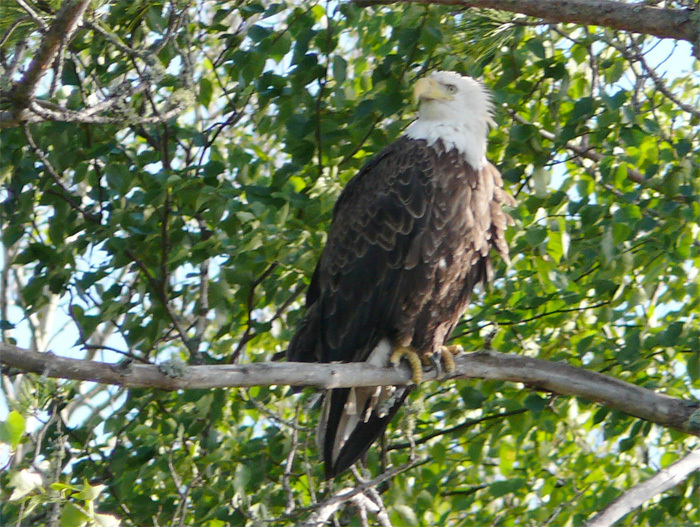A wind energy company is seeking federal approval to kill several bald eagles each year within the Mississippi River Flyway in southeastern Minnesota in the process of providing intermitten wind power for local electricity consumers.
Eight to 14 Kills Each Year
U.S. Fish and Wildlife Service (USFWS) officials report the proposed New Era Wind Farm will likely kill between eight and 14 bald eagles each year, in addition to numerous other protected birds and bats.
USFWS officials say wind farm operators may be able to reduce the number of anticipated bird and bat deaths through such measures as shutting down the wind turbines during migratory seasons and when birds and bats congregate in the area. Such measures, however, would reduce the efficiency of the wind turbines, which already fall short of efficiency and cost comparisons with conventional electricity generation.
Important Migratory Route
Each year, millions of birds pass through the portion of the Mississippi River Flyway targeted for the New Era Wind Farm. A study of another wind power site in southwestern Minnesota showed a 47 percent decline in regional raptor populations after wind turbines began operating.
Troubled History
Controversy has surrounded the 78-megawatt wind farm proposal since its inception. Originally known as AWA Goodshue Wind, the project’s first owner was Texas billionaire T. Boone Pickens’ Mesa Power Group. Minnesota residents viewed the Dallas-based company as something of an interloper, even after it established a subsidiary in Minneapolis known as National Wind.
National Wind worked closely with another Pickens-backed group, American Wind Alliance, to promote the project. Local resistance finally prompted the Pickens group to sell the project to local developer Peter Mastic in the fall of 2012. Shortly thereafter, Mastic changed the project’s name to New Era Wind Farm.
New Era is the first wind-energy facility in the nation granted USFWS approval to apply for an “Incidental Take Permit” (ITP). An ITP would allow the accidental killing of bald eagles in the course of normal business operations without threat of federal prosecution under the 1940 Bald and Golden Eagle Protection Act. USFWS has yet to render a final decision on the actual permit application.
State Officials Express Concern
New Era has also filed an updated Avian and Bat Protection Plan (ABPP), as required under Minnesota law. The Minnesota Public Utilities Commission in February 2012 rejected the original ABPP, submitted when the project was still owned by Pickens’ Mesa Power. New Era’s updated ABPP may also be in for tough sledding with both federal and state officials. USFWS has already rejected the updated ABPP’s assertion that the proposed wind farm would kill only about one eagle every other year.
The Minnesota Department of Natural Resources raised additional concerns that the rapidly spinning rotors on the project’s 48 turbines will pose a threat to Northern Harriers, Henslow Sparrows, bats, and other wildlife.
Golden eagles are another potential victim. Though they are not as common in southeastern Minnesota as bald eagles, golden eagles also fly through central Goodshue County, where the wind farm would be located. FWS has made it clear there is no possibility of New Era obtaining an ITP for golden eagles.
The USFWS estimates wind turbines kill at least 440,000 birds each year in the United States, including many threatened species. Wind turbines also kill a prodigious number of bats each year. Wildlife advocacy groups point to shortcomings in the USFWS counting methodology and say the number of bird deaths is likely much higher than USFWS claims.
Renewable Mandates Kill Wildlife
“Minnesota has added a significant amount of wind energy in the past few years, and this growth was primarily driven by the state renewable mandate,” said Todd Wynn, director of the Energy, Environment and Agriculture Task Force at the American Legislative Exchange Council.
“Unfortunately, policymakers often overlook the consequences of these mandates,” Wynn explained. “Beyond bird deaths, renewable mandates are the death knell for Minnesota’s economy, which will see higher electricity rates and lower job growth by forcing more expensive, less reliable energy onto the state’s electricity grid.”
Bonner R. Cohen, Ph. D., ([email protected]) is a senior fellow at the National Center for Public Policy Research.





